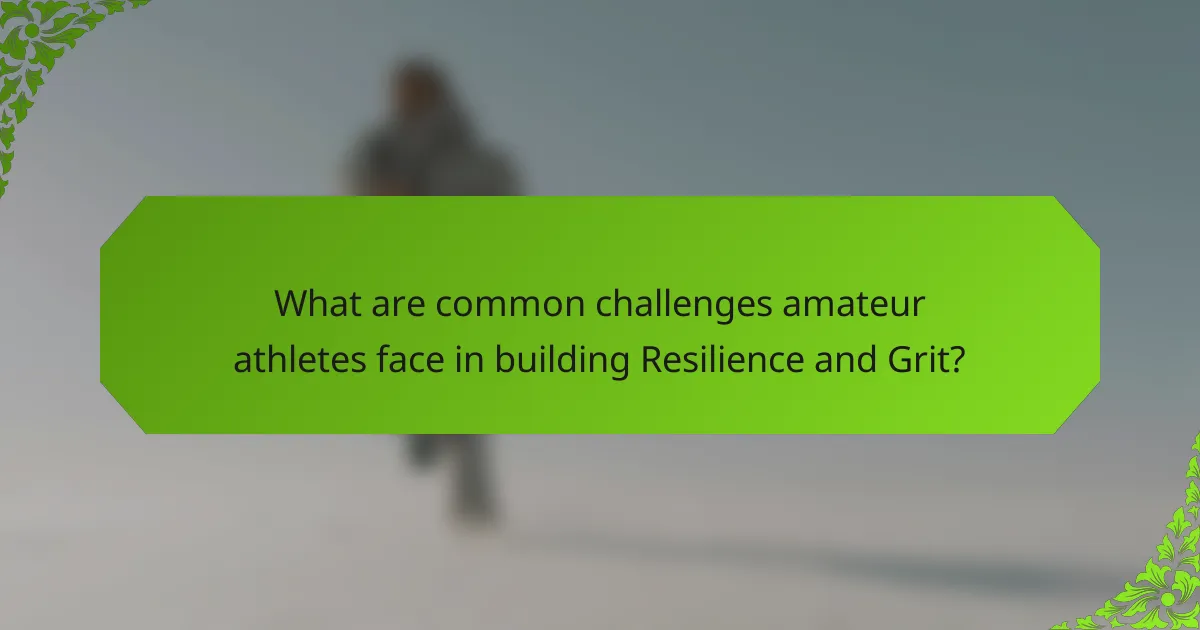Resilience and grit are vital for amateur athletes striving to overcome challenges and achieve their goals. This article explores how to build mental toughness, implement effective strategies, and address common obstacles faced in athletics. Techniques like goal setting, visualization, and maintaining a positive mindset enhance resilience and foster perseverance. Understanding these concepts can lead to improved performance and greater success in competitive environments.

What is Resilience and Grit in Amateur Athletics?
Resilience and grit are essential for amateur athletes, enabling them to overcome challenges and achieve their goals. Resilience refers to the ability to bounce back from setbacks, while grit encompasses perseverance and passion for long-term objectives. Together, these traits foster mental toughness, allowing athletes to maintain focus and motivation despite obstacles. Studies show that athletes with high levels of resilience and grit are more likely to succeed in competitive environments, demonstrating the importance of these attributes in amateur athletics.
How do Resilience and Grit contribute to athletic performance?
Resilience and grit significantly enhance athletic performance by fostering mental toughness and enabling athletes to overcome challenges. Resilience allows athletes to bounce back from setbacks, while grit drives sustained effort toward long-term goals. Research shows that athletes with high levels of resilience are more likely to maintain performance under pressure. Additionally, grit correlates with increased perseverance, leading to improved training outcomes and success in competitions. Together, these attributes create a robust mindset essential for achieving excellence in amateur athletics.
What are the psychological aspects of Resilience and Grit?
Resilience and grit are essential psychological traits for amateur athletes, enabling them to overcome challenges and achieve their goals. Resilience involves the ability to recover from setbacks, while grit represents perseverance and passion for long-term objectives. Together, they foster mental toughness, allowing athletes to maintain focus and motivation despite difficulties. Research indicates that athletes with high levels of resilience and grit are more likely to perform consistently and reach their potential. For example, a study found that grit significantly predicts success in sports, highlighting its role in sustained effort and commitment.

What are the universal practices for developing Resilience and Grit?
Building resilience and grit involves adopting practices that enhance mental toughness and the ability to overcome setbacks. Key practices include setting clear goals, maintaining a positive mindset, embracing challenges, and learning from failures.
Regularly assessing progress helps in adjusting strategies, while seeking support from coaches and peers fosters a strong support network. Engaging in reflective practices, such as journaling, can aid in understanding emotions and experiences.
Additionally, consistent training routines build discipline and reinforce commitment to personal growth. Visualization techniques can enhance focus on goals and improve performance under pressure.
Finally, cultivating a growth mindset encourages viewing obstacles as opportunities for development, ultimately leading to greater resilience and grit in amateur athletics.
How can goal-setting enhance Resilience?
Goal-setting enhances resilience by providing clear objectives and a roadmap for overcoming challenges. It fosters a sense of purpose, motivating athletes to persist through setbacks. Setting specific, measurable goals helps track progress, reinforcing mental toughness. As a result, athletes develop grit, enabling them to face adversity with confidence and determination. This process cultivates a growth mindset, where failures become learning opportunities, ultimately leading to greater achievements in amateur athletics.
What role does self-reflection play in building Grit?
Self-reflection is crucial in building grit as it fosters self-awareness and resilience in amateur athletes. By analyzing their experiences, athletes can identify strengths and weaknesses, enabling them to adapt their strategies for overcoming challenges. This process enhances mental toughness and commitment to long-term goals. Regular self-reflection promotes a growth mindset, allowing athletes to learn from setbacks and maintain motivation. Ultimately, this practice cultivates a deeper sense of purpose and determination, essential for achieving success in sports.
What are effective coping strategies for setbacks?
Effective coping strategies for setbacks include developing a positive mindset, setting realistic goals, and seeking support from others. These approaches enhance resilience and grit in amateur athletics. Practicing mindfulness can also help athletes remain focused and calm during challenges. Additionally, reflecting on past experiences enables individuals to learn and adapt, fostering mental toughness.

What unique techniques can amateur athletes use to cultivate mental toughness?
Amateur athletes can cultivate mental toughness through techniques like visualization, goal setting, and positive self-talk. Visualization helps athletes mentally rehearse success, enhancing confidence. Setting specific, achievable goals provides direction and motivation. Positive self-talk reinforces resilience during challenges, promoting a growth mindset. Together, these techniques foster grit and perseverance, essential for overcoming setbacks and achieving athletic goals.
How does visualization improve performance and resilience?
Visualization enhances performance and resilience by enabling athletes to mentally rehearse scenarios and develop coping strategies. This mental practice can improve focus, reduce anxiety, and increase confidence during competitions. Visualizing success fosters a growth mindset, encouraging athletes to embrace challenges and persist through setbacks. Research indicates that athletes who regularly use visualization techniques report higher levels of mental toughness and improved goal achievement.
What role does community support play in developing Grit?
Community support is crucial in developing grit as it fosters resilience and encourages perseverance. Supportive networks provide emotional backing, practical resources, and motivation during challenges. Athletes often face setbacks; having a community to lean on can enhance their mental toughness. Studies show that social connections significantly impact persistence in achieving goals. Engaging with others who share similar experiences can instill a sense of belonging, which is a unique attribute that bolsters an athlete’s commitment to their objectives.

What are the rare attributes of Resilience and Grit that set top athletes apart?
Top athletes exhibit rare attributes of resilience and grit, such as adaptive thinking and emotional regulation. Adaptive thinking allows athletes to reframe challenges positively, enhancing problem-solving skills. Emotional regulation helps them manage stress effectively, maintaining focus during competition. These attributes set them apart by fostering a unique mental resilience that aids in overcoming setbacks and achieving long-term goals.
How can adaptability in training foster long-term resilience?
Adaptability in training enhances long-term resilience by promoting flexibility in athletes’ mental approaches. It encourages them to embrace challenges and adjust strategies when faced with setbacks. This adaptability fosters a growth mindset, leading to improved problem-solving skills and perseverance. Athletes who adapt effectively are more likely to maintain motivation and achieve their goals, ultimately building greater mental toughness over time.
What is the impact of emotional regulation on athletic performance?
Emotional regulation significantly enhances athletic performance by fostering resilience and grit. Athletes who effectively manage their emotions can better handle setbacks, maintain focus, and sustain motivation. Research shows that emotional regulation leads to improved mental toughness, enabling athletes to push through challenges. This skill also aids in reducing anxiety and stress, which can hinder performance. By cultivating emotional control, amateur athletes can achieve their goals more consistently and effectively.

What are common challenges amateur athletes face in building Resilience and Grit?
Amateur athletes commonly face challenges such as fear of failure, lack of support, and inconsistent motivation while building resilience and grit. These obstacles hinder their mental toughness and ability to overcome setbacks. Fear of failure can lead to anxiety, reducing performance and willingness to take risks. Lack of support from coaches or peers may result in feelings of isolation, making it difficult to stay committed. Inconsistent motivation can stem from unrealistic expectations or burnout, causing setbacks in goal achievement. Addressing these challenges is essential for fostering resilience and grit in amateur athletics.
What are the effects of burnout on mental toughness?
Burnout negatively impacts mental toughness by reducing resilience and grit. Athletes experiencing burnout may struggle with motivation, focus, and emotional stability. This decline affects their ability to overcome setbacks and achieve goals effectively. Research shows that prolonged burnout can lead to decreased performance and increased anxiety, further compounding challenges in amateur athletics. Recognizing burnout early is crucial for maintaining mental toughness and promoting recovery strategies.
How can athletes overcome fear of failure?
Athletes can overcome fear of failure by cultivating resilience and grit. Developing mental toughness involves embracing setbacks as learning opportunities. Practicing visualization techniques can enhance confidence and reduce anxiety. Setting realistic goals promotes a sense of achievement, while maintaining a supportive network fosters encouragement. Engaging in mindfulness exercises helps athletes stay present and focused.

What actionable strategies can amateur athletes implement immediately?
Amateur athletes can implement strategies like setting specific goals, practicing visualization, and embracing challenges. These actions build resilience and mental toughness.
1. Set SMART goals: Specific, Measurable, Achievable, Relevant, Time-bound.
2. Practice visualization: Imagine successful performances to enhance confidence.
3. Embrace challenges: View setbacks as opportunities for growth.
4. Maintain a positive mindset: Focus on progress, not perfection.
What are the best practices for maintaining motivation during training?
To maintain motivation during training, set clear goals, track progress, and celebrate small achievements. Incorporate variety in workouts to prevent monotony and engage with a supportive community. Develop a resilient mindset by embracing challenges and viewing setbacks as opportunities for growth. Consistently remind yourself of your passion for the sport to sustain enthusiasm.
What common mistakes should be avoided in the pursuit of Grit?
To pursue grit effectively, avoid common mistakes such as setting unrealistic goals, neglecting rest, and ignoring support systems. Setting achievable milestones fosters motivation. Adequate rest prevents burnout, while a strong support network enhances resilience. Recognizing these pitfalls aids in building mental toughness and achieving long-term success.
How can athletes optimize their mental training routines?
Athletes can optimize their mental training routines by incorporating specific strategies that enhance resilience and grit. Focus on setting clear, achievable goals to create a roadmap for progress. Implement visualization techniques to mentally rehearse performances, which builds confidence and prepares the mind for challenges. Regularly reflect on setbacks to identify lessons learned, fostering a growth mindset. Engage in mindfulness practices to enhance focus and emotional regulation. Lastly, seek social support from coaches and peers to maintain motivation and accountability.



